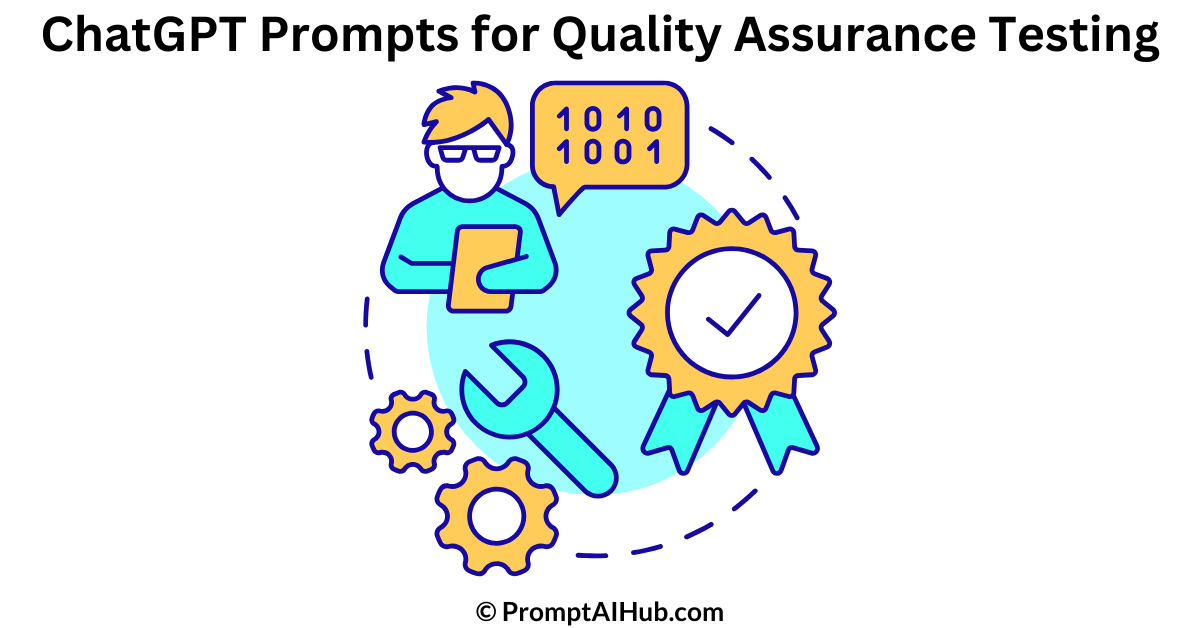Unlock the power of ChatGPT with our collection of 175 prompts tailored for Quality Assurance (QA) Testing. In the world of testing and quality assurance, efficiency is key. This article isn’t just a guide; it’s your toolkit for streamlining QA processes, ensuring precision, and mastering the art of testing. Read it thoroughly, because in the fast-paced realm of QA, every prompt counts.
Explore Our ChatGPT Prompts Library
ChatGPT Prompts for Quality Assurance (QA) Testing
1. Test Plan Development:
As a Quality Assurance expert, outline the essential components of a test plan for a [type of application]. Include sections on objectives, scope, testing strategy, resources, schedule, and deliverables.
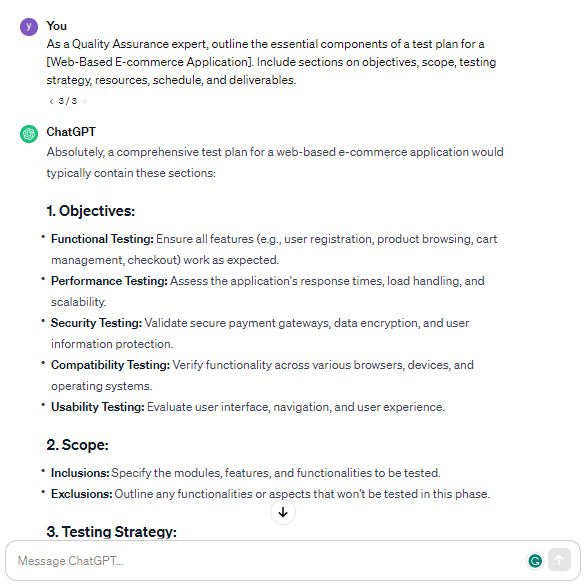
2. Test Case Design for [Specific Feature]:
Provide a detailed guide on designing test cases for a specific feature, such as [feature name]. Include considerations for positive and negative scenarios, inputs, expected results, and criteria for passing/failing.
3. Test Environment Setup for [Technology Stack]:
Explain the steps involved in setting up a test environment for an application built on [technology stack]. Discuss considerations for hardware, software, and network configurations.
4. Automated Testing Strategy for [Application Type]:
Discuss the benefits and challenges of implementing automated testing for [type of application]. Recommend an automated testing strategy considering factors like test coverage, maintainability, and execution speed.
5. Non-functional Testing for [Specific Aspect]:
Provide a comprehensive guide on conducting non-functional testing, focusing on [specific aspect, e.g., performance, security, usability]. Discuss tools and techniques relevant to the chosen aspect.
6. Regression Testing Best Practices for [Application Type]:
Outline best practices for regression testing in the context of [type of application]. Discuss strategies for selecting test cases, managing test data, and ensuring backward compatibility.
7. User Acceptance Testing (UAT) for [Project Phase]:
Explain the importance of User Acceptance Testing (UAT) during the [specific phase] of a project. Provide a step-by-step guide, including involving end-users, defining test scenarios, and criteria for UAT success.
8. Defect Lifecycle Management for [Project Type]:
Detail the process of defect lifecycle management for a [specific type of project]. Discuss defect reporting, tracking, prioritization, and verification steps.
9. Performance Testing Strategies for [Application Architecture]:
Discuss various performance testing strategies tailored for [specific application architecture, e.g., microservices, monolith]. Cover aspects like load testing, stress testing, and scalability testing.
10. Continuous Integration and Testing for [Technology Stack]:
Explain the concept of continuous integration and its integration with testing for an application built on [technology stack]. Discuss benefits, challenges, and best practices.
11. Security Testing Measures for [Application Type]:
Outline key measures for conducting security testing in [type of application]. Cover areas such as penetration testing, code reviews, and data encryption.
12. Test Documentation Best Practices for [Project]:
Discuss best practices for documenting test artifacts in the context of [specific project]. Emphasize the importance of clear and concise documentation for knowledge transfer and future reference.
13. Exploratory Testing Techniques for [Testing Context]:
Describe the techniques and principles of exploratory testing, focusing on [specific testing context, e.g., web applications, mobile apps]. Provide examples of scenarios where exploratory testing is particularly effective.
14. Usability Testing Guidelines for [Target Audience]:
Offer guidelines for conducting usability testing tailored to the [specific target audience, e.g., end-users, specific demographics]. Provide a usability testing checklist for validation.
15. Continuous Improvement in QA Processes for [Project Type]:
Discuss strategies for continuous improvement in the QA process, considering the specific challenges and requirements of [type of project]. Cover feedback loops, metrics tracking, and process optimization.
Visit: The 79 Best ChatGPT Chrome Extensions (Tried And Tested)
1. Test Plan Overview:
As a Quality Assurance expert, provide a detailed overview of a test plan for a new e-commerce website. Include sections on objectives, scope, testing types (e.g., functional, performance), resources, and a timeline. Also, explain the importance of each section in ensuring a thorough QA process.
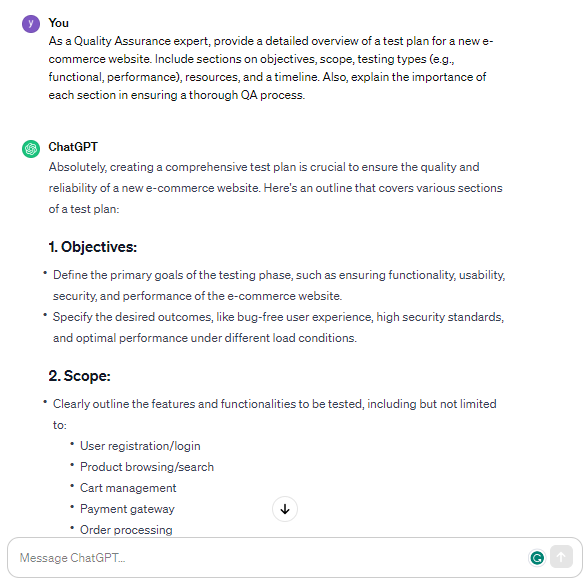
2. Test Case Design:
Discuss the principles of effective test case design. Outline the steps involved in creating a test case, including identifying test conditions, specifying inputs, expected results, and criteria for passing/failing. Provide an example test case for validating a user registration form on a website.
3. Test Environment Setup:
Explain the critical steps involved in setting up a test environment for a web application. Include considerations for hardware, software, and network configurations. Discuss the importance of maintaining consistency between the test and production environments.
4. Automated Testing Strategy:
Describe the benefits and challenges of automated testing. Recommend an automated testing strategy for a large-scale software project, considering factors like test coverage, maintainability, and execution speed. Include an example of a test case suitable for automation.
5. Non-functional Testing:
Provide a comprehensive guide on conducting non-functional testing. Cover different types such as performance, security, and usability testing. Discuss the tools and techniques that can be employed for each type of non-functional testing.
6. Regression Testing Best Practices:
Outline best practices for regression testing to ensure the stability of software during iterative development. Discuss strategies for selecting test cases, managing test data, and automating regression tests. Provide examples of scenarios where regression testing is crucial.
7. User Acceptance Testing (UAT):
Explain the importance of User Acceptance Testing (UAT) in the software development lifecycle. Provide a step-by-step guide for planning and executing UAT, including involvement of end-users, test scenarios, and criteria for UAT success.
8. Defect Lifecycle Management:
Detail the process of defect lifecycle management. Include steps for reporting, tracking, prioritizing, and verifying defects. Discuss the role of effective communication between QA and development teams in resolving defects.
9. Performance Testing Strategies:
Discuss various strategies for performance testing in a web application. Cover load testing, stress testing, and scalability testing. Explain how to analyze and interpret performance test results, and recommend improvements based on findings.
10. Continuous Integration and Testing:
Explain the concept of continuous integration and its impact on testing. Provide insights into how QA processes can be integrated into continuous integration pipelines. Discuss the benefits of early and automated testing in a CI/CD environment.
Visit: 99 Helpful ChatGPT Prompts For Day Trading
11. Security Testing Measures:
Outline key measures for conducting security testing in a web application. Cover areas such as penetration testing, code reviews, and data encryption. Discuss the role of QA in ensuring the robustness of security measures.
12. Test Documentation Best Practices:
Discuss best practices for documenting test artifacts. Include guidelines for maintaining clear and concise test documentation, such as test plans, test cases, and test results. Emphasize the importance of documentation in knowledge transfer and future reference.
13. Exploratory Testing Techniques:
Describe the techniques and principles of exploratory testing. Provide examples of scenarios where exploratory testing is particularly effective. Discuss how exploratory testing can complement scripted testing efforts.
14. Usability Testing Guidelines:
Offer guidelines for conducting usability testing. Discuss the importance of user feedback, test scenarios that capture user experience, and metrics for evaluating usability. Provide an example usability testing checklist for a mobile application.
15. QA Process Improvement:
Discuss strategies for continuous improvement in the QA process. Cover topics such as root cause analysis, feedback loops, and metrics tracking. Provide examples of how QA teams can learn from past testing cycles to enhance future processes.
16. Load Testing Strategies for Web Services:
Provide a detailed guide on load testing strategies for web services. Discuss considerations for simulating realistic user loads, measuring response times, and identifying performance bottlenecks. Include recommendations for tools suitable for load testing web services.
17. Accessibility Testing Best Practices:
Explain the importance of accessibility testing in ensuring inclusivity. Provide a step-by-step guide on testing for accessibility, covering screen reader compatibility, keyboard navigation, and color contrast. Include examples of assistive technologies commonly used by individuals with disabilities.
18. Compatibility Testing Across Browsers and Devices:
Outline a comprehensive approach to compatibility testing across different browsers and devices. Discuss challenges related to cross-browser compatibility and provide strategies for ensuring a consistent user experience.
19. Data Integrity Testing in Database Applications:
Detail the process of data integrity testing for database applications. Cover techniques for validating data accuracy, consistency, and completeness. Discuss considerations for testing data migrations and transformations.
20. Mobile App Testing Checklist:
Create a detailed checklist for testing a mobile application. Include items related to compatibility across devices, operating systems, usability on various screen sizes, and performance considerations specific to mobile platforms.
Visit: 145 Dynamic ChatGPT Prompts For Text Editing
21. API Testing Best Practices:
Discuss best practices for testing Application Programming Interfaces (APIs). Cover aspects such as endpoint validation, data format testing, and authentication checks. Provide examples of scenarios where API testing is crucial.
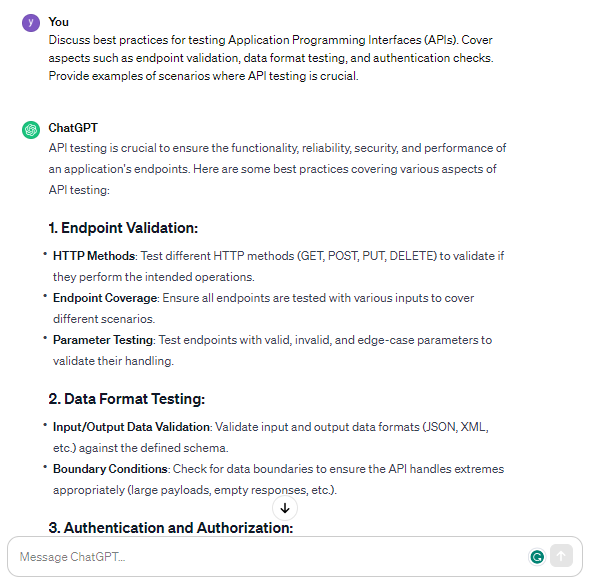
22. Effective Test Data Management:
Explain the importance of test data management in QA processes. Discuss strategies for creating and managing test data, including techniques for data anonymization and maintaining data consistency across test cycles.
23. Test Case Traceability Matrix:
Detail the concept of a Test Case Traceability Matrix (TCTM) and its role in QA. Provide a template for creating a TCTM and explain how it helps in ensuring that all requirements are covered by test cases.
24. Best Practices for Mobile Responsive Design Testing:
Offer best practices for testing the responsiveness of web applications on different devices and screen sizes. Discuss strategies for identifying and addressing issues related to mobile responsive design.
25. Exploratory Testing in Agile Development:
Discuss the integration of exploratory testing into Agile development methodologies. Provide insights into how exploratory testing can enhance agility, foster collaboration, and adapt to changing project requirements.
26. Risk-Based Testing Approach:
Explain the principles of a risk-based testing approach. Discuss how to identify and prioritize testing efforts based on project risks. Provide examples of scenarios where a risk-based approach is beneficial.
27. Test Execution and Reporting in Continuous Deployment:
Discuss strategies for efficient test execution and reporting in a continuous deployment environment. Cover topics such as parallel test execution, real-time reporting, and integration with deployment pipelines.
28. Test Environment Configuration Management:
Outline best practices for configuration management in test environments. Discuss version control for test configurations, environment provisioning automation, and strategies for maintaining consistency across different testing stages.
29. Behavior-Driven Development (BDD) Testing:
Explain the principles of Behavior-Driven Development (BDD) and its impact on testing. Provide examples of writing executable specifications using tools like Cucumber or SpecFlow. Discuss the collaboration between QA and development teams in BDD.
30. Metrics for Assessing Test Effectiveness:
Identify key metrics for assessing the effectiveness of the QA process. Discuss metrics related to test coverage, defect density, and test execution efficiency. Provide examples of how these metrics contribute to overall project quality.
Visit: 473 Best ChatGPT Prompts For Professionals
31. Cross-functional Collaboration in QA:
Explain the importance of cross-functional collaboration in QA. Discuss effective communication channels between QA, development, and other teams. Provide examples of how collaborative efforts contribute to a smoother testing process.
32. Cloud-Based Testing Strategies:
Discuss strategies for implementing testing in cloud environments. Cover considerations for scalability, security, and cost-effectiveness. Provide recommendations for tools and platforms suitable for cloud-based testing.
33. Chaos Engineering Principles for Resilience Testing:
Introduce the principles of chaos engineering and its application in resilience testing. Discuss how introducing controlled chaos can uncover system vulnerabilities and improve overall system reliability.
34. API Security Testing Techniques:
Outline techniques for conducting security testing on APIs. Cover topics such as authentication, authorization, and data encryption. Provide examples of common API security vulnerabilities and how to mitigate them.
35. A/B Testing in QA:
Explain the concept of A/B testing and its relevance in QA. Discuss how A/B testing can be used to compare two versions of a feature or functionality and make data-driven decisions about software improvements.
36. Compliance Testing in Regulated Industries:
Discuss the challenges and best practices for compliance testing in industries with strict regulatory requirements. Cover aspects related to data privacy, security standards, and documentation necessary for compliance.
37. Test-driven Development (TDD) Practices:
Provide an overview of Test-driven Development (TDD) practices. Discuss the role of writing tests before code development, and how it contributes to code quality, maintainability, and faster defect identification.
38. Test Data Generation Strategies:
Detail strategies for generating realistic and diverse test data. Discuss techniques for creating boundary test cases, positive and negative scenarios, and how to handle data variations in different environments.
39. Explaining Test Automation ROI:
Discuss how to measure and explain the Return on Investment (ROI) for test automation efforts. Cover factors such as time savings, increased test coverage, and reduced defect rates. Provide a template for calculating automation ROI.
40. QA for Machine Learning Models:
Explain the unique challenges and approaches to quality assurance for machine learning models. Discuss techniques for testing model accuracy, fairness, and robustness. Provide examples of QA processes specific to machine learning applications.
Visit: 245 Best ChatGPT Prompts For Goal Setting
41. Disaster Recovery Testing:
Provide a detailed guide on conducting disaster recovery testing for critical systems. Discuss the importance of having a robust recovery plan, testing different failure scenarios, and ensuring minimal downtime in case of a disaster.
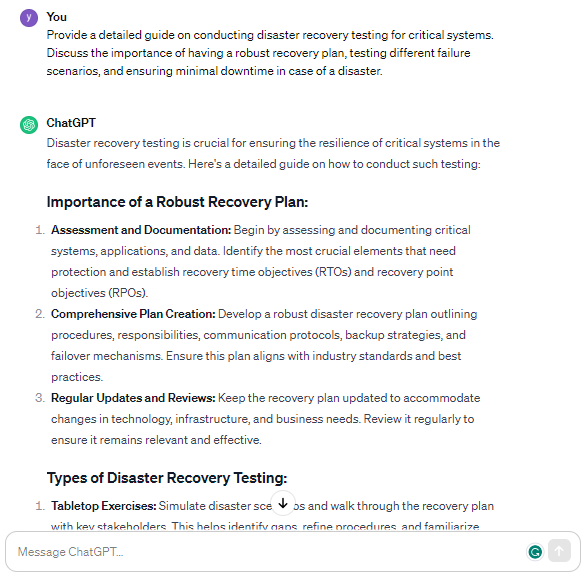
42. Internationalization (i18n) and Localization (l10n) Testing:
Explain the differences between internationalization and localization. Discuss testing strategies to ensure that software is culturally adaptable and linguistically accurate for a global audience. Provide examples of potential issues and testing scenarios.
43. Test Environment Security:
Outline best practices for ensuring the security of the test environment. Discuss measures such as data masking, access controls, and secure data transmission. Provide a checklist for securing the test environment against potential vulnerabilities.
44. Progressive Web App (PWA) Testing:
Discuss testing strategies for Progressive Web Apps (PWAs). Cover topics such as offline functionality, push notifications, and responsiveness across different devices. Provide examples of test cases for PWA-specific features.
45. Ethical Hacking in QA:
Introduce the concept of ethical hacking in the context of QA. Discuss how ethical hacking can uncover security vulnerabilities and strengthen the overall security posture of a software application. Provide examples of ethical hacking techniques.
46. Usability Testing for Accessibility:
Expand on usability testing to focus specifically on accessibility. Discuss testing methodologies that ensure a positive user experience for individuals with disabilities. Include examples of how usability testing can uncover accessibility issues.
47. Test Impact Analysis in Continuous Integration:
Explain the concept of test impact analysis and its role in continuous integration pipelines. Discuss how analyzing code changes helps identify relevant tests for execution, optimizing test cycles and resource usage.
48. Browser DevTools for QA:
Guide QA testers on utilizing browser Developer Tools for effective testing. Discuss how DevTools can be used for debugging, performance profiling, and monitoring network requests. Provide examples of scenarios where DevTools are valuable.
49. Compliance Testing for Web Accessibility Standards:
Detail the testing procedures for ensuring compliance with web accessibility standards such as WCAG (Web Content Accessibility Guidelines). Discuss how to assess and address issues related to accessibility compliance.
50. Performance Testing for Microservices Architecture:
Discuss specific considerations and strategies for performance testing in a microservices architecture. Cover topics such as service orchestration, load balancing, and the impact of microservices communication on overall system performance.
Visit: 119 Unique ChatGPT Prompts For Letter Of Recommendation
51. Blockchain Application Testing:
Provide guidance on testing applications built on blockchain technology. Discuss considerations for smart contract testing, security audits, and validating the integrity of transactions in decentralized applications.
52. API Documentation for QA:
Explain the importance of clear and comprehensive API documentation for QA processes. Discuss how well-documented APIs contribute to effective testing, and provide examples of essential information that should be included in API documentation.
53. Testing Micro Frontends:
Detail testing strategies for applications employing a micro frontend architecture. Discuss challenges related to component interactions, versioning, and independent deployments. Provide examples of how to ensure consistency and performance in micro frontend environments.
54. Voice Interface Testing:
Explore testing methodologies for voice interfaces, such as those used in virtual assistants and smart home devices. Discuss considerations for natural language processing, voice recognition, and testing in various ambient noise conditions.
55. IoT (Internet of Things) Device Testing:
Provide a comprehensive guide on testing Internet of Things devices. Discuss challenges related to connectivity, security, and interoperability. Include examples of test scenarios for ensuring the reliability of IoT ecosystems.
56. Test Data Privacy Compliance:
Discuss strategies for ensuring test data privacy compliance, especially in industries with stringent data protection regulations. Cover techniques for data anonymization, encryption, and secure handling of sensitive information during testing.
57. Test Oracles in QA:
Explain the concept of test oracles and their role in QA processes. Discuss how test oracles help determine the correctness of test results and provide examples of establishing effective oracles for different types of testing.
58. Progressive Delivery Testing:
Explore testing strategies for progressive delivery approaches, including feature flags, canary releases, and A/B testing. Discuss how QA teams can validate the gradual rollout of features while minimizing risks.
59. Testing AI-driven Applications:
Discuss testing considerations for applications powered by artificial intelligence. Cover aspects such as model validation, data bias testing, and evaluating the performance of machine learning algorithms in real-world scenarios.
60. Compliance Testing for Regulatory Standards:
Detail the process of compliance testing for applications subject to specific regulatory standards, such as HIPAA or GDPR. Discuss the documentation, testing procedures, and validation processes necessary to ensure regulatory compliance.
Visit: 133 Best ChatGPT Prompts For Generating Business Ideas
61. Chaos Testing for Resilience in Cloud-Native Environments:
Discuss the principles and practices of chaos testing specifically tailored for applications in cloud-native environments. Explore how introducing chaos can uncover weaknesses in distributed systems and enhance overall resilience.
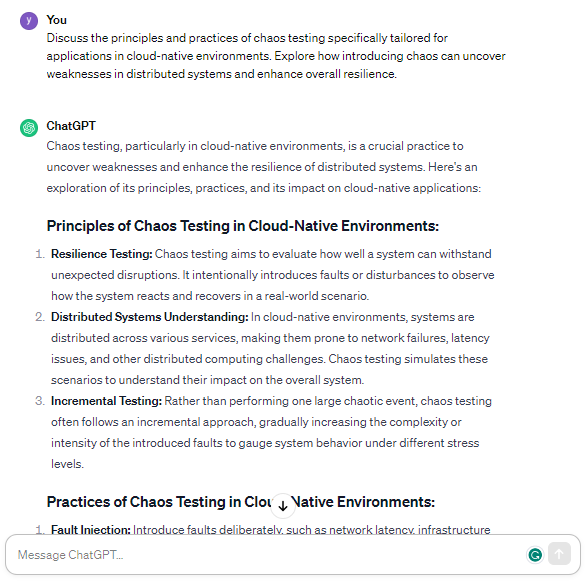
62. Biometric Authentication Testing:
Provide guidance on testing applications that incorporate biometric authentication methods, such as fingerprint or facial recognition. Discuss scenarios for testing accuracy, security, and error handling in biometric systems.
63. GraphQL API Testing Strategies:
Explore testing strategies for applications utilizing GraphQL APIs. Discuss the unique characteristics of GraphQL and how testing can ensure efficient data retrieval, query validation, and error handling.
64. Testing Augmented Reality (AR) and Virtual Reality (VR) Applications:
Detail testing methodologies for applications leveraging augmented reality (AR) and virtual reality (VR) technologies. Cover considerations for user interaction, immersive experiences, and compatibility across various AR/VR devices.
65. Performance Testing for Serverless Architectures:
Discuss performance testing strategies specific to serverless architectures. Explore considerations for function execution times, scalability, and the impact of event-driven triggers on overall performance.
66. Chatbot Testing Techniques:
Provide guidance on testing conversational interfaces, such as chatbots. Discuss strategies for validating natural language processing, user intent recognition, and ensuring seamless interactions in different conversational scenarios.
67. Testing for Microservices Security:
Detail security testing measures for applications built on microservices architecture. Cover considerations for secure communication, authentication, and authorization between microservices. Discuss strategies for detecting and mitigating security vulnerabilities.
68. Compliance Testing for Payment Card Industry Data Security Standard (PCI DSS):
Explore compliance testing procedures for applications handling payment card data. Discuss the specific requirements outlined in PCI DSS and how QA testing can validate adherence to these standards.
69. Testing Quantum Computing Applications:
Discuss the emerging field of testing applications in quantum computing. Cover considerations for quantum algorithms, error correction, and validating the performance of quantum computing solutions.
70. Testing Robotic Process Automation (RPA) Workflows:
Provide guidance on testing applications that leverage robotic process automation (RPA) for automating business processes. Discuss scenarios for validating workflow automation, exception handling, and integration with other systems.
Visit: 61 Easy And Well Defined Google Bard Prompts For Business Plans
71. Testing Edge Computing Applications:
Explore testing strategies for applications deployed in edge computing environments. Discuss considerations for latency, connectivity, and resilience in distributed edge architectures. Provide examples of test scenarios to validate edge computing applications.
72. Testing Decentralized Finance (DeFi) Platforms:
Discuss testing methodologies for decentralized finance platforms built on blockchain technology. Cover aspects such as smart contract audits, security token testing, and validating decentralized financial transactions.
73. Testing Extended Reality (XR) Applications:
Provide guidance on testing extended reality (XR) applications, including augmented reality (AR), virtual reality (VR), and mixed reality (MR). Discuss considerations for spatial interactions, user interfaces, and immersive experiences.
74. Testing Quantum-Safe Cryptography:
Explore testing strategies for applications implementing quantum-safe cryptographic algorithms. Discuss the challenges and considerations for ensuring the security of cryptographic protocols in the era of quantum computing.
75. Regulatory Compliance Testing for Healthcare Applications:
Detail the testing procedures for healthcare applications to ensure compliance with industry-specific regulations such as Health Insurance Portability and Accountability Act (HIPAA). Cover data security, privacy, and interoperability testing.
76. Testing Explainable Artificial Intelligence (XAI):
Discuss testing approaches for explainable artificial intelligence models. Cover scenarios where interpretability and transparency are critical, and provide examples of how to validate the explainability of AI-driven decisions.
77. Testing Natural Language Generation (NLG) Systems:
Provide guidance on testing applications that involve natural language generation (NLG) systems. Discuss scenarios for evaluating the coherence, relevance, and linguistic accuracy of machine-generated text.
78. Testing for Smart Cities Applications:
Explore testing strategies for applications contributing to smart city initiatives. Discuss considerations for interoperability, data security, and real-time data processing in applications that support smart city infrastructure.
79. Test Data Bias in Machine Learning:
Discuss strategies for identifying and mitigating biases in test data used for machine learning models. Cover the importance of diverse and representative datasets and provide examples of how biased data can impact model performance.
80. Testing for Energy-Efficient Software:
Explore testing methodologies focused on the energy efficiency of software applications. Discuss considerations for resource consumption, power usage, and strategies for optimizing software for minimal environmental impact.
Visit: 301 Tested Bing AI Prompts For Business
81. Quantum-Safe Communication Protocol Testing:
Discuss testing strategies for communication protocols designed to be secure against quantum attacks. Explore scenarios for key exchange, encryption, and validating the resilience of quantum-safe communication channels.
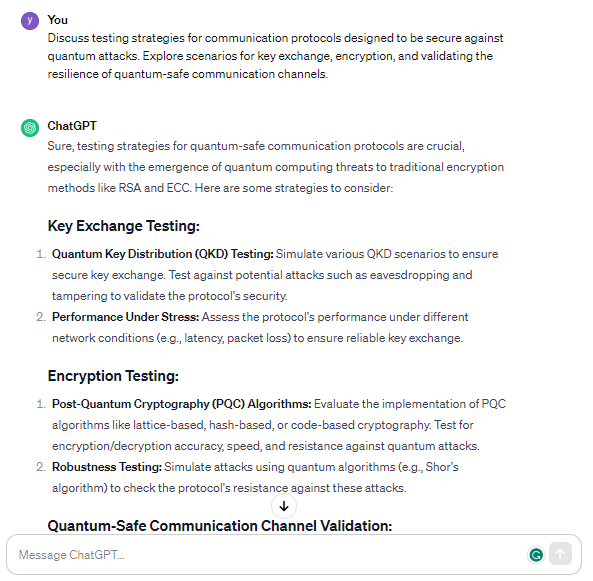
82. Testing Autonomous Vehicle Systems:
Provide guidance on testing autonomous vehicle systems, including self-driving cars. Cover scenarios for sensor validation, decision-making algorithms, and real-time communication between vehicles and infrastructure.
83. Testing for Explainable Machine Learning Models:
Discuss testing methodologies for ensuring the explainability of machine learning models. Cover scenarios where model outputs need to be interpretable, and provide examples of how to validate the transparency of model decisions.
84. Zero Trust Security Model Testing:
Explore testing strategies for applications implementing a Zero Trust security model. Discuss considerations for continuous authentication, access controls, and securing microservices in a Zero Trust architecture.
85. Testing Inclusive Design for Accessibility:
Provide guidance on testing for inclusive design to ensure accessibility for users with diverse abilities. Cover considerations for cognitive accessibility, sensory-friendly design, and usability testing for inclusivity.
86. Testing Federated Learning Systems:
Discuss testing methodologies for applications that implement federated learning, where machine learning models are trained across decentralized devices. Cover scenarios for model synchronization, privacy preservation, and ensuring robustness in federated learning systems.
87. Testing OpenAI Language Models:
Explore testing strategies specifically designed for OpenAI language models like GPT-3. Discuss scenarios for evaluating natural language understanding, response coherence, and mitigating potential biases in generated text.
88. Testing Edge AI Applications:
Provide guidance on testing applications that leverage edge computing for artificial intelligence processing. Discuss considerations for model deployment at the edge, latency optimization, and real-time inference testing.
89. Testing Responsible AI Practices:
Discuss strategies for testing AI applications with a focus on ethical and responsible AI practices. Cover scenarios for fairness testing, avoiding algorithmic bias, and ensuring adherence to ethical guidelines in AI development.
90. Testing for Digital Twins:
Explore testing methodologies for applications implementing digital twins, which are virtual replicas of physical objects or systems. Discuss considerations for synchronization, data accuracy, and validating the real-time simulation of physical entities.
Visit: 141 Tested Google Bard Prompts For Marketing
91. Testing Quantum Key Distribution (QKD) Systems:
Explore testing strategies for Quantum Key Distribution (QKD) systems, which use quantum mechanics to secure communication channels. Discuss scenarios for key exchange, quantum entanglement, and testing the security of QKD implementations.
92. Testing Blockchain Smart Contracts:
Provide guidance on testing smart contracts deployed on blockchain platforms. Cover considerations for contract functionality, security audits, and testing for vulnerabilities such as reentrancy and gas optimization.
93. Testing for Deepfake Detection Systems:
Discuss testing methodologies for applications focused on detecting deepfake content. Cover scenarios for image and video analysis, identifying manipulated media, and ensuring the reliability of deepfake detection algorithms.
94. Continuous Compliance Testing in DevSecOps:
Explore strategies for integrating continuous compliance testing into DevSecOps pipelines. Discuss considerations for automating compliance checks, security scanning, and ensuring that code changes comply with regulatory standards.
95. Testing Responsible AI for Bias and Fairness:
Provide guidance on testing AI applications for bias and fairness. Discuss techniques for identifying and mitigating bias in machine learning models, and explore scenarios for testing the fairness of AI-driven decision-making.
96. Testing Synthetic Data Generation:
Discuss testing strategies for applications that generate synthetic data. Cover considerations for data quality, realism, and scenarios for testing the effectiveness of synthetic data in training machine learning models.
97. Testing Augmented Analytics Applications:
Explore testing methodologies for applications that incorporate augmented analytics, combining artificial intelligence with business intelligence. Discuss considerations for data analysis, natural language processing, and ensuring the accuracy of augmented insights.
98. Testing for Explainable AI in Healthcare:
Provide guidance on testing healthcare applications that utilize explainable AI models. Discuss scenarios for validating the interpretability of AI-driven diagnostic recommendations and ensuring transparent communication of results to healthcare professionals.
99. Testing for Decentralized Identity Systems:
Discuss testing strategies for applications implementing decentralized identity systems using blockchain or distributed ledger technology. Cover considerations for privacy, secure key management, and verifying the integrity of decentralized identities.
100. Testing Cyber-Physical Systems Security:
Explore testing methodologies for ensuring the security of cyber-physical systems (CPS), which integrate computation and physical processes. Discuss scenarios for validating secure communication, sensor inputs, and resilience against cyber-physical attacks.
Visit: 600+ Well-Structured Bing Chat Prompts For Marketing
101. Testing Quantum Computing Algorithms:
Discuss testing strategies for quantum computing algorithms. Cover considerations for quantum gate operations, algorithmic correctness, and performance in a quantum computing environment.
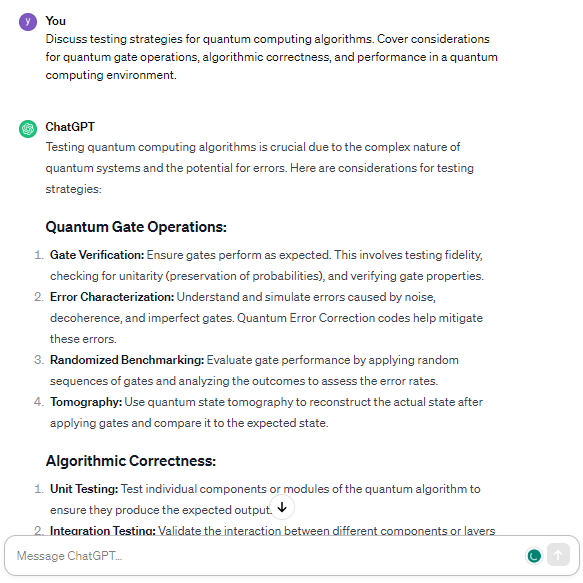
102. Testing Conversational AI for Emotional Intelligence:
Provide guidance on testing conversational AI systems for emotional intelligence. Discuss scenarios for recognizing and responding to user emotions, and explore considerations for natural and empathetic interactions.
103. Testing for Cybersecurity Threat Intelligence Platforms:
Explore testing methodologies for cybersecurity threat intelligence platforms. Discuss considerations for threat data analysis, threat detection accuracy, and integration with security information and event management (SIEM) systems.
104. Testing Explainable AI in Financial Predictions:
Provide guidance on testing financial prediction models that incorporate explainable AI. Discuss scenarios for interpreting model predictions, ensuring transparency in algorithmic decisions, and validating accuracy in financial forecasting.
105. Testing Robotic Process Automation (RPA) for Hyperautomation:
Discuss testing strategies for applications implementing hyperautomation through RPA. Cover scenarios for end-to-end process automation, integration with diverse systems, and ensuring the reliability of automated workflows.
106. Testing for Quantum Cryptography Protocols:
Explore testing considerations for quantum cryptography protocols, which leverage quantum properties for secure communication. Discuss scenarios for quantum key distribution, encryption, and validation of quantum-resistant cryptographic algorithms.
107. Testing Human Augmentation Technologies:
Provide guidance on testing applications that leverage human augmentation technologies. Discuss scenarios for testing wearable devices, augmented reality interfaces, and the integration of technology with human capabilities.
108. Testing Explainable Machine Learning for Healthcare Diagnostics:
Explore testing methodologies for explainable machine learning models in healthcare diagnostics. Discuss scenarios for interpreting diagnostic predictions, validating accuracy, and ensuring transparent communication of results to healthcare professionals.
109. Testing Multi-Experience Development Platforms:
Discuss testing strategies for multi-experience development platforms that enable the creation of applications for various user interfaces, including voice, chat, and augmented reality. Cover scenarios for cross-platform compatibility and consistent user experiences.
110. Testing Quantum-Safe Blockchain Networks:
Provide guidance on testing blockchain networks with quantum-resistant cryptographic mechanisms. Discuss considerations for securing transactions, consensus algorithms, and ensuring the overall resilience of quantum-safe blockchain networks.
Visit: 7 Best Free Chrome Extensions For Bing AI Chat (Tried & Tested)
111. Testing Edge AI for Smart Edge Devices:
Discuss testing methodologies for applications leveraging edge AI on smart edge devices. Cover considerations for model inference, resource optimization, and ensuring efficient AI processing on edge devices.
112. Testing Quantum Machine Learning Algorithms:
Explore testing strategies for quantum machine learning algorithms. Discuss considerations for quantum-enhanced model training, algorithmic accuracy, and assessing the quantum advantage in machine learning tasks.
113. Testing Natural Language Generation for Content Creation:
Provide guidance on testing applications that use natural language generation for content creation. Discuss scenarios for linguistic accuracy, creativity assessment, and ensuring coherent and contextually relevant generated content.
114. Testing for Ethical AI in Hiring Platforms:
Discuss testing strategies for AI-driven hiring platforms to ensure ethical and unbiased candidate evaluation. Cover considerations for diversity, fairness, and transparency in AI-based hiring decisions.
115. Testing Quantum Cryptocurrency Networks:
Explore testing considerations for blockchain networks built for quantum-resistant cryptocurrencies. Discuss scenarios for secure transactions, quantum-resistant consensus mechanisms, and overall security in quantum cryptocurrency networks.
116. Testing Hyperautomation in Business Processes:
Provide guidance on testing hyperautomation solutions that integrate various technologies for end-to-end business process automation. Discuss scenarios for workflow orchestration, system integrations, and validating business rule execution.
117. Testing for Responsible AI in Education Technology:
Discuss testing methodologies for AI-driven applications in education technology. Cover considerations for ethical use of AI in educational content, personalized learning, and ensuring fairness and inclusivity.
118. Testing Quantum-Safe Post-Quantum Cryptography:
Explore testing strategies for post-quantum cryptographic algorithms designed to be secure against both classical and quantum attacks. Discuss scenarios for secure key exchange, encryption, and cryptographic protocol testing.
119. Testing Cross-Reality (XR) Collaboration Platforms:
Provide guidance on testing cross-reality collaboration platforms that integrate augmented reality (AR), virtual reality (VR), and mixed reality (MR) for collaborative experiences. Discuss scenarios for seamless interactions and content sharing across different reality environments.
120. Testing Edge AI for Autonomous Drones:
Discuss testing methodologies for applications using edge AI in autonomous drone systems. Cover considerations for real-time image processing, navigation accuracy, and ensuring safe and reliable drone operations.
Visit: 200+ Best Google Bard Prompts For Investors
121. Testing Responsible AI in Criminal Justice Systems:
Explore testing strategies for AI applications used in criminal justice systems. Discuss considerations for fairness, transparency, and accountability in AI-driven decision-making processes within legal frameworks.
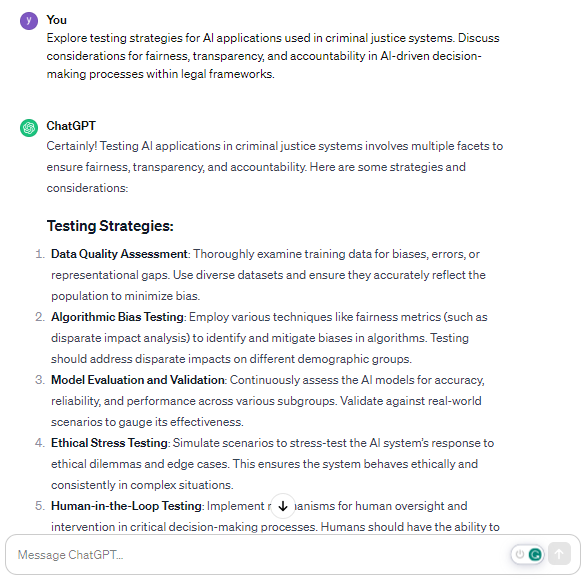
122. Testing Quantum-Safe Blockchain Interoperability:
Provide guidance on testing interoperability between blockchain networks implementing quantum-safe cryptographic mechanisms. Discuss scenarios for secure cross-chain transactions and ensuring compatibility between quantum-safe blockchain networks.
123. Testing Spatial Computing Applications:
Discuss testing methodologies for spatial computing applications that blend physical and digital realities. Cover considerations for spatial awareness, user interactions, and seamless integration of spatial computing technologies.
124. Testing Explainable AI in Regulatory Compliance:
Explore testing strategies for AI applications that assist in regulatory compliance, emphasizing the importance of interpretability and transparency in AI-driven compliance decisions. Discuss scenarios for model explainability and regulatory adherence.
125. Testing Quantum-Safe Internet of Things (IoT) Networks:
Provide guidance on testing IoT networks secured with quantum-safe cryptographic protocols. Discuss considerations for securing communication between IoT devices, quantum-resistant key management, and overall network resilience.
126. Testing Human-Centric AI in Personalized Healthcare:
Discuss testing methodologies for AI applications in personalized healthcare. Cover considerations for patient-centric AI interactions, ethical use of health data, and validation of AI-driven personalized healthcare recommendations.
127. Testing Federated Learning in Edge Computing Environments:
Explore testing strategies for federated learning implementations in edge computing environments. Discuss scenarios for model aggregation, secure communication, and validating the effectiveness of federated learning across edge devices.
128. Testing for AI-driven Climate Modeling:
Provide guidance on testing applications that use AI for climate modeling. Discuss scenarios for accuracy validation, model robustness, and ensuring the reliability of AI-driven predictions in climate science.
129. Testing Ethical AI in Social Media Content Moderation:
Discuss testing methodologies for AI-driven content moderation in social media platforms. Cover considerations for fairness, transparency, and the ethical use of AI in moderating user-generated content.
130. Testing Quantum-Safe Voting Systems:
Explore testing strategies for quantum-safe cryptographic implementations in electronic voting systems. Discuss considerations for secure vote transmission, quantum-resistant cryptographic protocols, and overall security in quantum-safe voting systems.
Visit: 55 Helpful Google Bard Prompts For Finance
131. Testing Ethical AI in News Recommendation Systems:
Explore testing strategies for AI-driven news recommendation systems. Discuss considerations for fairness, diversity, and minimizing algorithmic bias in recommending news articles to users.
132. Testing Quantum-Safe Cloud Computing Environments:
Provide guidance on testing quantum-safe cryptographic implementations in cloud computing environments. Discuss scenarios for secure data transmission, key management, and overall security in quantum-safe cloud computing.
133. Testing Explainable AI in Judicial Decision Support Systems:
Discuss testing methodologies for AI applications that support judicial decision-making. Cover considerations for interpretability, transparency, and accountability in AI-driven decision support systems within the legal domain.
134. Testing AI-driven Personal Financial Management:
Explore testing strategies for AI-driven personal financial management applications. Discuss scenarios for accuracy in financial predictions, security of financial data, and user-friendly interactions.
135. Testing Quantum-Safe Supply Chain Blockchain:
Provide guidance on testing blockchain networks with quantum-safe cryptographic mechanisms specifically designed for securing supply chain transactions. Discuss scenarios for secure supply chain provenance and logistics tracking.
136. Testing Explainable AI in Customer Service Chatbots:
Discuss testing methodologies for AI-driven customer service chatbots, emphasizing the importance of explainability and transparency in customer interactions. Cover scenarios for coherent responses and ethical handling of user queries.
137. Testing Quantum-Safe Health Information Exchanges:
Explore testing strategies for quantum-safe cryptographic implementations in health information exchange systems. Discuss considerations for securing patient data, quantum-resistant encryption, and overall security in health information exchanges.
138. Testing AI-driven Personalized Learning Platforms:
Provide guidance on testing AI-driven platforms for personalized learning. Discuss scenarios for adaptive learning algorithms, student engagement, and validating the effectiveness of AI-driven personalized education recommendations.
139. Testing Ethical AI in Facial Recognition Systems:
Discuss testing methodologies for facial recognition systems, emphasizing fairness, privacy, and ethical use of biometric data. Cover considerations for accuracy, bias mitigation, and user consent in facial recognition technology.
140. Testing Quantum-Safe Critical Infrastructure Networks:
Explore testing strategies for implementing quantum-safe cryptographic protocols in critical infrastructure networks. Discuss considerations for secure communication, encryption, and overall resilience in quantum-safe critical infrastructure systems.
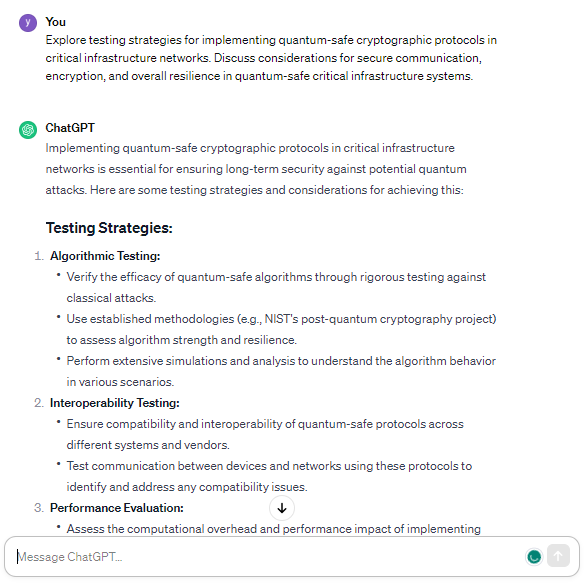
141. Testing Responsible AI in Criminal Profiling Systems:
Explore testing strategies for AI applications used in criminal profiling. Discuss considerations for fairness, transparency, and avoiding biases in AI-driven decision-making processes within law enforcement.
142. Testing Quantum-Safe Smart Grids:
Provide guidance on testing smart grids secured with quantum-safe cryptographic protocols. Discuss scenarios for securing communication between smart devices in the grid, quantum-resistant key management, and overall network resilience.
143. Testing Explainable AI in Mental Health Diagnosis Apps:
Discuss testing methodologies for AI-driven applications that assist in mental health diagnosis. Cover considerations for interpretability, ethical use of personal health data, and validation of AI-driven mental health assessments.
144. Testing Quantum-Safe Industrial Control Systems:
Explore testing strategies for implementing quantum-safe cryptographic protocols in industrial control systems. Discuss considerations for secure communication, encryption, and overall resilience in quantum-safe industrial control systems.
145. Testing AI-driven Predictive Policing Algorithms:
Provide guidance on testing AI applications used in predictive policing. Discuss scenarios for fairness, accountability, and minimizing biases in AI-driven predictive policing algorithms.
146. Testing Quantum-Safe Autonomous Vehicles Communication:
Explore testing strategies for quantum-safe communication between autonomous vehicles. Discuss scenarios for secure communication, quantum-resistant encryption, and overall network resilience in autonomous vehicle networks.
147. Testing Explainable AI in Human Resources Decision Systems:
Discuss testing methodologies for AI-driven decision systems in human resources. Cover considerations for interpretability, transparency, and avoiding biases in AI-driven hiring and employee management systems.
148. Testing Quantum-Safe Surveillance Systems:
Provide guidance on testing surveillance systems secured with quantum-safe cryptographic protocols. Discuss scenarios for secure data transmission, quantum-resistant encryption, and overall security in quantum-safe surveillance systems.
149. Testing AI-driven Emergency Response Systems:
Explore testing strategies for AI applications used in emergency response systems. Discuss scenarios for accuracy in predicting emergency events, ethical use of AI in crisis situations, and minimizing biases in response recommendations.
150. Testing Quantum-Safe Smart Healthcare Devices:
Discuss testing considerations for smart healthcare devices secured with quantum-safe cryptographic protocols. Explore scenarios for secure communication, patient data protection, and overall security in quantum-safe healthcare devices.
Visit: Unlock Success With These 67 Google Bard Prompts For Trading
151. Testing Ethical AI in Autonomous Weapon Systems:
Explore testing strategies for AI-driven autonomous weapon systems, emphasizing ethical considerations, transparency, and accountability. Discuss scenarios for ensuring responsible use of AI in the context of autonomous weaponry.
152. Testing Quantum-Safe Smart Agriculture Systems:
Provide guidance on testing smart agriculture systems secured with quantum-safe cryptographic protocols. Discuss scenarios for secure communication between agricultural devices, quantum-resistant encryption, and overall network resilience.
153. Testing Explainable AI in Legal Document Analysis:
Discuss testing methodologies for AI-driven legal document analysis systems. Cover considerations for interpretability, accuracy in understanding legal language, and transparency in AI-driven legal document interpretation.
154. Testing Quantum-Safe Autonomous Flying Vehicles Communication:
Explore testing strategies for quantum-safe communication between autonomous flying vehicles, such as drones. Discuss scenarios for secure communication, quantum-resistant encryption, and overall network resilience in aerial vehicle networks.
155. Testing AI-driven Social Credit Scoring Systems:
Provide guidance on testing AI applications used in social credit scoring systems. Discuss scenarios for fairness, transparency, and avoiding biases in AI-driven social credit scoring algorithms.
156. Testing Quantum-Safe Smart Water Management Systems:
Explore testing strategies for smart water management systems secured with quantum-safe cryptographic protocols. Discuss scenarios for secure communication between water management devices, quantum-resistant encryption, and overall network resilience.
157. Testing Explainable AI in Scientific Research Assistance:
Discuss testing methodologies for AI-driven systems that assist in scientific research. Cover considerations for interpretability, accuracy in providing research insights, and transparency in AI-driven scientific assistance.
158. Testing Quantum-Safe Personalized Medicine Platforms:
Provide guidance on testing personalized medicine platforms secured with quantum-safe cryptographic protocols. Discuss scenarios for secure patient data transmission, quantum-resistant encryption, and overall security in quantum-safe healthcare platforms.
159. Testing AI-driven Disaster Response Systems:
Explore testing strategies for AI applications used in disaster response systems. Discuss scenarios for accuracy in predicting and responding to disasters, ethical use of AI in crisis situations, and minimizing biases in response recommendations.
160. Testing Quantum-Safe Smart Energy Grids:
Discuss testing considerations for smart energy grids secured with quantum-safe cryptographic protocols. Explore scenarios for secure communication, quantum-resistant encryption, and overall security in quantum-safe energy grid systems.
Visit Our Free AI tools
Prompts AI Hub Team Has Tailored Their AI Knowledge and Created Tools for You Free of Cost, Enjoy
Final Thoughts:
Elevate your QA testing game with our meticulously crafted 175 ChatGPT prompts, designed to optimize efficiency and precision. Embrace the power of these prompts to enhance your QA processes. Stay ahead in the dynamic world of quality assurance by leveraging our comprehensive guide for a seamless testing experience.
Download All Prompts
To Download 50K Plus Prompts Click Below and Get Them In One Click.
Q1: How to use ChatGPT in QA testing?
To leverage ChatGPT in QA testing, formulate specific prompts that align with your testing objectives. Craft prompts to simulate user interactions, generate test cases, or validate system responses. Incorporate diverse scenarios to assess the versatility and robustness of your application. Experiment with iterative testing using ChatGPT to uncover unique perspectives and uncover potential issues.
Q2: Will ChatGPT replace QA?
While ChatGPT can enhance QA processes by generating test cases and providing diverse inputs, it’s not a replacement for comprehensive QA testing. QA involves a holistic approach, including manual testing, automation, and strategic planning. ChatGPT serves as a valuable tool within this framework, automating certain aspects and augmenting efficiency. However, the human intuition, creativity, and critical thinking skills of QA testers remain irreplaceable.
Q3: How can I be a good quality assurance tester?
To excel as a quality assurance tester, cultivate a deep understanding of the application under test. Develop strong communication skills to collaborate effectively with developers and stakeholders. Stay updated on industry trends, tools, and testing methodologies. Prioritize attention to detail, maintain a curious mindset, and embrace continuous learning. Actively participate in test planning, design, and execution to ensure thorough testing coverage.
Q4: How do I practice QA testing?
Practice QA testing by engaging in hands-on activities, such as creating test cases, executing test scenarios, and analyzing results. Utilize testing tools and frameworks to gain technical proficiency. Collaborate with peers to understand different perspectives and approaches. Explore real-world applications and simulate diverse testing scenarios. Join online QA communities, attend workshops, and stay informed about the latest testing practices to refine your skills continuously.
For More Information, About Author Visit Our Team

